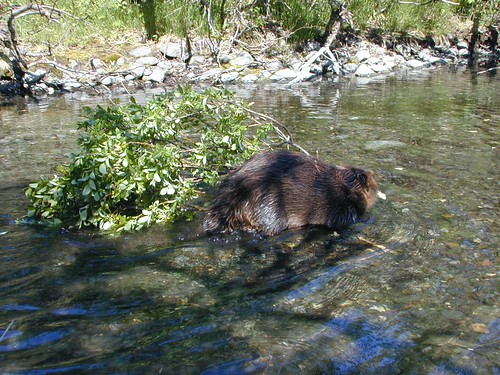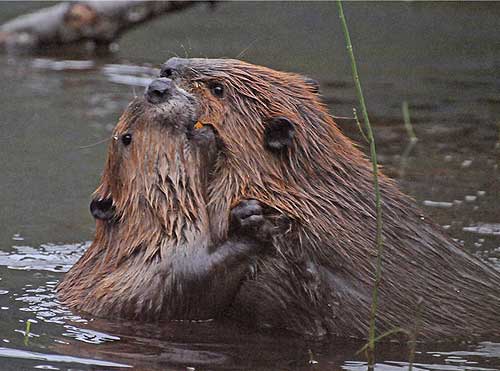
A busy beaver gathers a tree sprig to help build his lodge on Steep Creek on Alaska’s Tongass National Forest. Photo courtesy of Don Martin, Tongass National Forest
Two beavers sleep peacefully in their den on Steep Creek in Juneau, Alaska, never realizing they are being watched via a hidden infrared camera. Hundreds of viewers tune-in to a live video feed on theU.S. Forest Service YouTube Channel throughout the day to see the beavers come and go, breathing rhythmically as they nap and then stretch, chew and scratch an occasional itch.
Although the beaver cam is now an established fixture at the Mendenhall Glacier Visitor Center, it started out of simple curiosity according to Pete Schneider, a natural resource specialist for theTongass National Forest. He and fisheries biologist Don Martin first experimented with a beaver cam in 2004 after they saw a cache of food in front of a beaver lodge on Steep Creek. It was a sure indication that beavers, who have a tendency to move around, were actually using the lodge at the time. They decided to run electricity through a conduit to that location in order to power an infrared camera.
Schneider and Martin rigged their first camera on a piece of rebar, and poked it through a hole in the lodge. “It worked like an upside down periscope,” Schneider said. “We could twist it left and right and move it up and down. Don, who was watching a handheld monitor, said, ‘Hey, there’s a beaver right there!’ That was our start.”
They fixed the camera in place, insulated it, and attached it to a closed-circuit monitor which could be seen in the visitor center, even in the winter. It was a great show, but limited to those who were at the glacier in person. It would be years before it became possible to live stream the video on the internet.
The two beavers in the lodge this summer have already received thousands of web views. In the past, Schneider has seen as many as eight at a time in residence.
Opinions differ about the value of beavers in the ecosystem at Steep Creek. Beaver tend to have the most positive impact in areas that lack ponds and slow water rearing areas. Steep Creek is not in short supply of either due to its location by Mendenhall Lake and nearby kettle ponds, which are holes created by melting ice chunks. Beaver can plug culverts that extend under roads or temporarily inhibit the movement of substrate—spawning salmon need that constant movement of gravel for their nests. If the beaver population grows too robust, they could impact access to the spawning grounds for adult fish.
Nevertheless, Forest Service staff have managed a workable balance in allowing the beavers to share the rich resources of this area.
Beavers are primarily nocturnal and usually occupy the lodge during the day. To date, the cam has received more than 70,000 minutes of watch time from viewers across the United States as well as foreign countries with an average watch time of about 15 minutes. Best viewing times are between 7 a.m. and 7 p.m. Alaska Standard Time.

Beavers are part of the web of life in Steep Creek near the Mendenhall Glacier on Alaska’s Tongass National Forest. Photo: Tongass National Forest
No comments:
Post a Comment
Note: Only a member of this blog may post a comment.